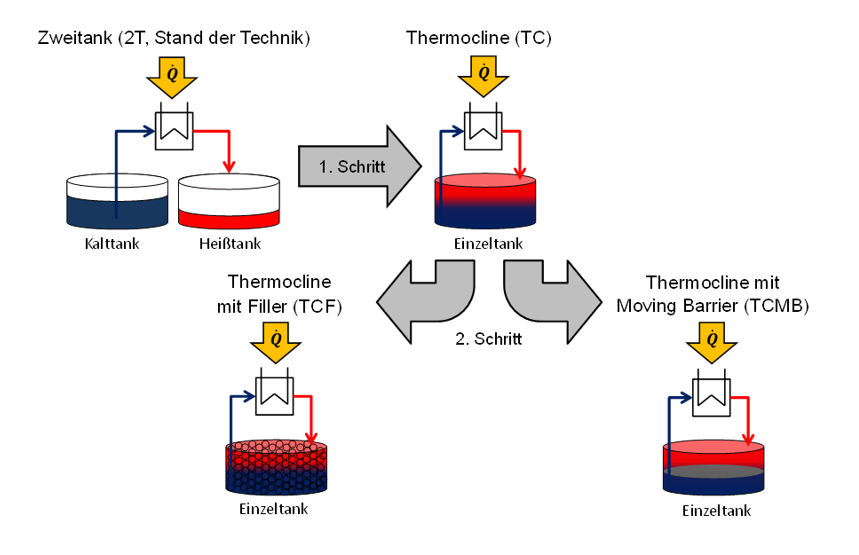MoBaCline- Moving Barrier Thermocline
High-temperature one tank storage with moving barrier
Project duration: Oct 2020 - Sept 2022
The expansion of renewable energy is a declared goal of the German government and requires the development of storage solutions. High-temperature storage systems based on molten salt are a proven technology that can be used in a variety of ways. Originally developed for solar thermal power plants, they can also be integrated in conventional power plants and in process plants to be expanded into electricity-heat-electricity storage systems to make the electricity market more flexible. In the latest Integrated CSP/PV hybrid power plants (ICPH), the technology is also poised for a renaissance in its original field of application.State of the art is the two-tank concept – one for relatively cool (but at 300°C still liquid) salt, one for hot salt at up to 565°C. In the MoBaCline project is intended to explore a novel single-tank storage concept, in which the hot and cool liquid salt are stored together in one tank. The hot salt floats on top of the cool salt due to its lower density. The single-tank concept generally has some advantages, such as smaller space requirement, saving a tank, cheaper pumping equipment, and avoiding a large volume of gas exchange with the environment. Various approaches are currently conceivable for the single-tank concept. Between hot and cool salt, there is a temperature transition zone, the so-called thermocline, which cannot be used thermally or only to a limited extent, so that an increase in the salt supply is required. As a result, the salt requirement here could higher than in the two-tank concept. A significant cost reduction can be achieved with the one-tank concept with filler. Here, a large quantity of salt is substituted by low-cost rock.
In the MoBaCline project, a single-tank storage system with a moving barrier will be investigated. The idea is to use a movable insulated barrier whose density is lower than that of the cold salt and higher than that of the hot salt, so that it floats in-between and separates the hot and cold salt layers. This separating barrier moves up and down during the operation of the storage tank. This prevents the salt layers from mixing, keeping the hot salt hot, and the mechanically sensitive floor cool. In addition, the outlet temperature remains nearly constant because the insulated interface has a much lower thermal conductivity than the salt. Thus, the aim is to limit the thermocline thickness as much as possible so that no additional salt is needed for it.
A prototype of the most suitable moving barrier will then be designed, built and tested in the Test Facility for Heat Storage in Molten Salt (TESIS) operated by our project Partner, the DLR Institute of Technical Thermodynamics in Cologne. Finally, the market potential of the single-tank storage concept developed and researched in the project will be evaluated and compared with the state of the art using annual simulations and electricity production costs.

Das Vorhabens MoBaCline wurde mit Mitteln des Bundesministeriums für Wirtschaft und Energie unter dem Förderkennzeichen 03EE5007A gefordert. Die Verantwortung für den Inhalt dieser Veröffentlichung liegt beim Autor / der Autorin.

